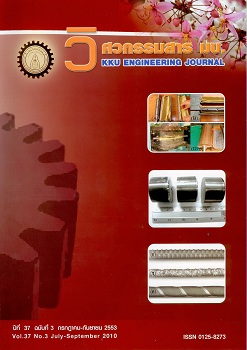Degradation of Humic acid from aqueous solution by Fenton reaction and microbiological technique
Main Article Content
Abstract
Humic substances (HS) are the components in soils, sediments, and waters (ground and surfacewater) and they are formed by the decay of plant, animal and microbial cell. The presence of humicsubstances may result in the formation of trihalomethanes (THMs) during the chlorination process in drinkingwater supplies. THMs are identified as a human carcinogen compound by the US Environmental ProtectionAgency (US EPA). The degradation of humic acid (HA) from synthetic humic acid solutions was carried out byFenton reaction and microbiological technique. The Fenton reaction is the formation of hydroxyl radicals (}OH)from the catalytic decomposition of hydrogen peroxide (H2O2) by soluble ferrous ion (Fe2+). The hydroxylradicals (}OH) is a strong oxidizing agent for the destruction of organic pollutants. At pH 3.0 of Fenton solutionshowed the maximum percentage of HA solution removal from the humic acid solution. The optimal ratio ofHA:H2O2:Fe2+ for extracted HA solution appeared to be 1:560:140 giving the maximum HA removal of 66 % atreaction time of 180 minutes. The two microorganisms; Pseudomonas fluorescens (P. fluorescens) andLactococcus lactis (L. lactis) were evaluated for degradation of HA. The highest HA removal from solutionwas observed when P. fluorescens was used as a single culture, with 33% efficiency within 27 days treatment.
Article Details
How to Cite
Suchaiya, T., Krongthong, P., Yoswathana, N., & Jonglertjunya, W. (2012). Degradation of Humic acid from aqueous solution by Fenton reaction and microbiological technique. Engineering and Applied Science Research, 37(3), 247–255. retrieved from https://ph01.tci-thaijo.org/index.php/easr/article/view/1711
Issue
Section
ORIGINAL RESEARCH
This work is licensed under a Creative Commons Attribution-NonCommercial-NoDerivatives 4.0 International License.



